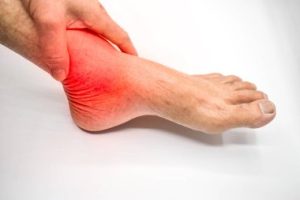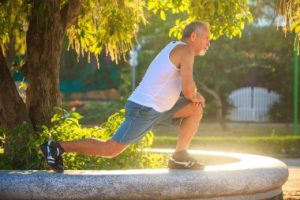
Can Exercise Trigger Gout (8 Important Factors)
Can exercise trigger gout? Despite its numerous health benefits, intense physical activity may precipitate gout attacks in susceptible individuals. Understanding the interplay between exercise and gout is crucial for effective management and prevention strategies. In the dynamic interplay between health and activity, the relationship between exercise and gout stands as a curious conundrum, where the pursuit of fitness may unwittingly stir the fiery echoes of this ancient affliction.
Imagine a scenario where the rhythmic thump of sneakers against pavement or the exertion of lifting weights transforms from a pathway to vitality into an unexpected trigger for the agony of gout. It’s a paradoxical dance where the very act of promoting wellness could, for some, unlock the gates to discomfort.
Delving into this intriguing intersection unveils a narrative rich with physiological complexities, lifestyle intricacies, and the timeless tug-of-war between the desire for an active life and the realities of bodily limitations. Let’s embark on a journey through the labyrinth of exercise-induced gout, where the pursuit of health takes unexpected turns, and every step forward may unearth a new facet of this enigmatic condition.

Can Exercise Trigger Gout
Yes, exercise can trigger gout in some individuals. Gout is a type of arthritis caused by high levels of uric acid in the blood, which can form crystals in the joints, leading to pain and inflammation. Exercise, particularly intense or high-impact activities, can exacerbate gout symptoms in susceptible individuals.
Understanding Gout and Exercise
Gout is a form of inflammatory arthritis characterized by sudden and severe attacks of pain, swelling, and redness in the joints, often affecting the big toe. It occurs when urate crystals accumulate in the joints, leading to inflammation. While exercise is generally recommended for managing gout, certain types of physical activity can potentially trigger gout attacks.
Impact of Exercise on Gout Attacks
Exercise can lead to increased production of uric acid, especially during intense or prolonged physical activity. Additionally, dehydration during exercise can raise uric acid levels in the blood, increasing the risk of gout attacks. High-impact activities such as running, jumping, or intense weightlifting may put excessive stress on the joints, triggering gout symptoms in susceptible individuals.
Managing Gout During Exercise
Individuals with gout can still enjoy the benefits of exercise by opting for low-impact activities such as swimming, cycling, or walking. It’s essential to stay hydrated before, during, and after exercise to help prevent uric acid buildup. Gradually increasing the intensity and duration of exercise can also help minimize the risk of gout attacks.
Understanding Gout
Definition and symptoms of gout
Gout is a form of arthritis characterized by sudden, severe attacks of pain, redness, swelling, and tenderness in the joints. It typically affects the big toe, but can also occur in other joints like the ankles, knees, elbows, wrists, and fingers. Symptoms include intense joint pain, inflammation, and discomfort, often accompanied by warmth and redness in the affected area.
Causes and risk factors of gout
Gout is caused by the buildup of uric acid crystals in the joints, leading to inflammation and pain. Risk factors include diet high in purines (found in certain foods like red meat, seafood, and alcohol), obesity, genetics, age, gender (men are more prone), certain medications (like diuretics), and underlying health conditions (such as hypertension and diabetes).
Pathophysiology of gout
In gout, the body either produces too much uric acid or fails to excrete it efficiently, leading to hyperuricemia. When uric acid levels become too high, they form crystals that deposit in the joints, triggering an inflammatory response. This inflammation causes the intense pain, swelling, and redness characteristic of gout attacks.
Diagnosis and management of gout
Diagnosing gout typically involves a physical examination, medical history review, and tests such as blood tests to measure uric acid levels and joint fluid analysis to detect crystals. Management involves medications to relieve pain and inflammation (like NSAIDs and corticosteroids), lifestyle changes (diet modification, weight loss, and reducing alcohol intake), and medications to lower uric acid levels (such as xanthine oxidase inhibitors and uricosuric agents).

Exercise and Its Benefits
Definition of Exercise
Exercise refers to physical activity performed to improve or maintain health and fitness. It encompasses a wide range of activities, from structured workouts such as running, weightlifting, and yoga to everyday tasks like walking, gardening, and taking the stairs. The primary goal of exercise is to enhance cardiovascular health, muscular strength, flexibility, and overall well-being.
Additionally, exercise plays a crucial role in managing weight, reducing stress, and improving mood. Whether undertaken individually or as part of a group, exercise is a vital component of a healthy lifestyle, promoting longevity and vitality
Benefits of Regular Exercise
Regular exercise offers a myriad of benefits that extend far beyond just physical health. Engaging in consistent physical activity has been shown to improve cardiovascular health, boost metabolism, and enhance overall strength and flexibility. Beyond the physical advantages, exercise also plays a crucial role in mental well-being by reducing stress, anxiety, and symptoms of depression.
It fosters better sleep patterns, sharpens cognitive function, and enhances mood through the release of endorphins. Moreover, regular exercise promotes longevity and reduces the risk of chronic diseases such as heart disease, diabetes, and certain cancers. It cultivates discipline, resilience, and self-confidence, empowering individuals to lead healthier, more fulfilling lives. Ultimately, incorporating exercise into one’s routine not only improves physical fitness but also contributes to a happier, more balanced lifestyle.
Types of Exercise Recommended for General Health
Regular exercise is vital for maintaining overall health and well-being, and there are various types of exercises recommended to achieve this. Aerobic exercises, such as walking, jogging, swimming, and cycling, help improve cardiovascular health by increasing heart rate and oxygen intake.
Strength training exercises, such as weightlifting and bodyweight exercises like push-ups and squats, build muscle strength and endurance, enhancing metabolism and bone density. Flexibility and balance exercises, including yoga and tai chi, promote agility and reduce the risk of injury by improving range of motion and stability. Incorporating a combination of these exercises into a weekly routine can contribute to optimal physical fitness and help prevent chronic diseases, fostering a healthier and more active lifestyle.
Relationship Between Exercise and Various Health Conditions
Exercise plays a crucial role in managing and preventing various health conditions. For example, it can help lower blood pressure, reduce cholesterol levels, and improve blood sugar control in individuals with hypertension, hyperlipidemia, and diabetes, respectively. Moreover, regular physical activity can alleviate symptoms of depression and anxiety, boost mood, and enhance cognitive function. It is essential for overall health maintenance and disease prevention.

The Link Between Exercise and Gout
Overview of studies examining the relationship between exercise and gout
Studies examining the relationship between exercise and gout have shed light on the complex interplay between physical activity and this inflammatory arthritis. Gout, characterized by the deposition of uric acid crystals in joints, has historically raised concerns about exercise exacerbating symptoms due to increased production of uric acid during strenuous activity. However, recent research suggests that moderate exercise may actually confer benefits for gout patients.
Regular physical activity has been associated with lower serum uric acid levels, reduced risk of gout attacks, and improved overall joint health. Furthermore, exercise promotes weight loss and helps maintain a healthy body mass index, which is crucial for managing gout since obesity is a significant risk factor.
While intense exercise might transiently elevate uric acid levels, the long-term benefits of regular, moderate activity outweigh the potential risks for most individuals with gout. Nevertheless, it is essential for gout patients to consult with healthcare professionals to tailor an exercise regimen that balances the benefits of physical activity with the need to prevent gout flare-ups.
Factors influencing gout development during exercise
Several factors can influence the development of gout during exercise, a condition characterized by sudden, severe attacks of pain, redness, and tenderness in the joints, often the big toe. Dehydration, a common occurrence during prolonged physical activity, can lead to the concentration of uric acid in the body, a key factor in gout flare-ups.
Poorly fitting footwear or improper exercise techniques may exacerbate joint stress, triggering gout symptoms. Furthermore, medications used to manage conditions like hypertension or diuretics, commonly prescribed alongside exercise regimens, may elevate uric acid levels.
Finally, dietary choices, particularly high-purine foods like red meat, seafood, and alcohol, can contribute to gout risk, especially when combined with strenuous physical activity. Thus, understanding these multifaceted influences is crucial in mitigating the risk of gout during exercise and maintaining overall joint health.
Mechanisms by which exercise may trigger gout attacks
Exercise can paradoxically trigger gout attacks through several mechanisms. Firstly, intense physical activity can lead to dehydration, causing an increase in uric acid concentration in the bloodstream, which may precipitate as urate crystals in the joints, triggering an acute gout flare.
Additionally, exercise-induced muscle damage releases purines, which are metabolized into uric acid, further elevating serum urate levels. Moreover, sudden and strenuous exercise can promote rapid breakdown of muscle tissue, resulting in the release of cellular contents including purines, exacerbating hyperuricemia.
Furthermore, exercise-related trauma to joints can stimulate inflammation, providing a fertile environment for urate crystal deposition and subsequent gouty inflammation. Therefore, while exercise is generally beneficial for overall health, individuals predisposed to gout should be mindful of their exercise intensity and hydration status to minimize the risk of gout attacks.
Understanding the role of uric acid levels in gout exacerbation during exercise
Understanding the role of uric acid levels in gout exacerbation during exercise is crucial for effectively managing this condition. Gout, a form of arthritis, is characterized by the accumulation of uric acid crystals in the joints, leading to inflammation and intense pain. Exercise can potentially trigger gout attacks due to various factors, including dehydration, increased production of uric acid, and stress on the joints.
Research suggests that during exercise, there is a temporary rise in uric acid levels in the blood, which may predispose individuals with gout to experiencing flare-ups. Furthermore, dehydration during exercise can concentrate uric acid levels, further increasing the risk of gout exacerbation. Therefore, monitoring uric acid levels and implementing strategies to prevent dehydration, such as staying hydrated and avoiding excessive alcohol consumption, are essential in managing gout and reducing the likelihood of flare-ups during physical activity.
Types of Exercise and Gout Risk
Impact of different types of exercise on gout risk
When it comes to managing gout, understanding how various exercises affect the condition is crucial. Certain exercises can either alleviate or exacerbate gout symptoms. By analyzing the relationship between exercise types and gout risk, individuals can tailor their fitness routines for optimal management.
Aerobic exercises and their effect on gout
Aerobic exercises, such as walking, swimming, and cycling, are renowned for their cardiovascular benefits. These low-impact activities help improve circulation and maintain a healthy weight, which can reduce the risk of gout flare-ups. Incorporating aerobic exercises into one’s routine can promote overall well-being while mitigating gout symptoms.
Resistance training and gout exacerbation
Resistance training, involving weightlifting and bodyweight exercises, is beneficial for muscle strength and bone health. However, individuals with gout should approach such activities with caution. Intense resistance training may potentially trigger gout flare-ups due to increased strain on the joints. It’s essential to balance resistance training with adequate rest and proper hydration to minimize gout exacerbation.
Impact of high-intensity exercise on gout attacks
High-intensity exercises, like sprinting or HIIT (High-Intensity Interval Training), can provide efficient workouts but may pose risks for those with gout. The intense nature of these exercises can lead to rapid uric acid release, potentially triggering gout attacks. Individuals prone to gout should consider lower-impact alternatives or consult healthcare professionals for personalized exercise recommendations.

Factors Influencing Gout Risk During Exercise
Dehydration and its role in gout flare-ups
Dehydration exacerbates gout during exercise by increasing uric acid concentration in the blood. Staying hydrated helps prevent gout attacks. Hydration level influences gout risk significantly. Maintaining adequate fluid intake is crucial during physical activity to mitigate gout symptoms. Dehydration worsens joint inflammation, a common symptom of gout.
Dietary factors affecting gout susceptibility during exercise
Certain foods high in purines can elevate uric acid levels, increasing the risk of gout during exercise. Purine-rich foods like red meat and shellfish are notorious triggers. Alcohol consumption can also exacerbate gout symptoms during physical activity. Limiting purine intake is essential for managing gout during exercise. Dietary choices play a pivotal role in gout prevention during workouts.
Importance of proper warm-up and cool-down in preventing gout attacks
Effective warm-up and cool-down routines can help reduce the risk of gout flare-ups during exercise. Proper warm-up prepares the body for physical exertion, minimizing stress on joints affected by gout. Cooling down properly aids in flushing out toxins and reducing inflammation post-exercise. Incorporating warm-up and cool-down exercises into workout routines is crucial for gout management. Warm-up and cool-down routines are integral to preventing gout attacks during physical activity.
Influence of medication and supplements on gout risk during exercise
Medication and supplements can impact gout risk during exercise significantly. Anti-inflammatory drugs help manage gout symptoms during physical activity. Allopurinol and febuxostat are commonly prescribed medications to lower uric acid levels and reduce gout flare-ups. Vitamin C supplements may also decrease the risk of gout during exercise by lowering uric acid levels. Consulting a healthcare professional for personalized medication and supplement advice is essential for gout management during workouts. Medication and supplements play a crucial role in mitigating gout risk during physical activity.
Recommendations for Individuals with Gout
Safe Exercise Guidelines for Individuals with Gout
Engaging in physical activity with gout requires caution to prevent flare-ups. Low-impact exercises such as walking, swimming, or cycling are ideal. Incorporate gentle stretches and strength training to improve joint function. Avoid high-impact activities like running or intense weightlifting to prevent joint stress and inflammation.
Strategies to Minimize Gout Risk During Exercise
Hydration is key to flushing out uric acid and reducing the risk of gout attacks during exercise. Maintain a balanced diet low in purines to prevent uric acid buildup. Wear supportive footwear to alleviate joint strain and minimize the risk of injury. Gradually increase exercise intensity to allow the body to adapt without triggering gout symptoms.
Importance of Consulting Healthcare Professionals for Personalized Advice
Individuals with gout should consult healthcare professionals, such as rheumatologists or physiotherapists, for personalized exercise recommendations. Health experts can assess individual risk factors and tailor exercise plans accordingly. Regular check-ups ensure that exercise routines align with overall gout management strategies and minimize complications.
Integrating Exercise into Gout Management Plans
Exercise plays a vital role in managing gout by improving joint mobility and overall health. Incorporate exercise sessions into weekly routines to maintain consistency. Monitor gout symptoms and adjust exercise intensity accordingly. Collaborate with healthcare professionals to develop comprehensive management plans that include tailored exercise regimens for long-term gout control.
Future Directions and Research Needs
Areas for further research on exercise and gout
Areas for further research on exercise and gout could encompass several dimensions to deepen our understanding and optimize management strategies. Firstly, investigating the precise mechanisms through which exercise impacts uric acid metabolism and inflammation pathways in gout patients is crucial. This includes exploring the effects of different types, intensities, and durations of exercise on serum uric acid levels and inflammatory markers.
Additionally, longitudinal studies examining the long-term impact of exercise interventions on gout flare frequency, joint damage progression, and overall disease progression are needed. Moreover, research focusing on personalized exercise prescriptions tailored to individual gout patients’ needs and preferences could enhance adherence and efficacy.
Furthermore, exploring the potential synergistic effects of exercise in combination with dietary modifications and pharmacological treatments for gout management warrants attention. Finally, investigating the psychosocial aspects, such as the influence of exercise on pain perception, quality of life, and mental well-being in gout patients, could provide valuable insights into holistic approaches to disease management. Addressing these research gaps can contribute significantly to optimizing exercise recommendations and improving outcomes for individuals living with gout.
Potential interventions to mitigate gout risk during exercise
Mitigating the risk of gout during exercise involves several potential interventions aimed at reducing uric acid buildup and minimizing inflammation. Hydration plays a crucial role; ensuring adequate fluid intake before, during, and after exercise helps maintain uric acid solubility and promotes its excretion through urine.
Additionally, incorporating a balanced diet rich in low-purine foods, such as fruits, vegetables, and whole grains, while limiting high-purine foods like red meat and seafood, can help manage uric acid levels. Proper warm-up and cool-down routines before and after exercise sessions can alleviate stress on joints and prevent sudden spikes in uric acid due to intense physical activity. Furthermore, incorporating moderate-intensity exercise rather than high-intensity workouts can help avoid excessive strain on the joints and minimize the risk of gout flare-ups.
Importance of longitudinal studies in understanding long-term effects of exercise on gout
Tracking gout patients over extended periods to observe exercise’s impact on flare-ups. Assessing how exercise habits correlate with gout progression and severity. Examining the relationship between exercise adherence and long-term gout management. Identifying factors influencing sustained exercise benefits for individuals with gout.
Advancements in personalized medicine for individuals with gout and exercise considerations
Utilizing genetic profiling to tailor exercise recommendations for gout patients. Integrating wearable technology to monitor exercise’s real-time effects on gout symptoms. Exploring pharmacogenomics to optimize medication response during exercise for gout patients. Implementing telemedicine for personalized exercise counseling for individuals with gout.
Frequently Asked Questions (FAQs) about Can Exercise Trigger Gout
Q1. Can exercise trigger gout attacks?
A. While exercise is generally beneficial, intense physical activity can occasionally trigger gout attacks in some individuals. It may result from increased production of uric acid during exercise or the breakdown of muscle tissue.
Q2. What types of exercise are more likely to trigger gout?
A. High-impact activities such as sprinting, weightlifting, and prolonged endurance exercises may have a higher likelihood of triggering gout attacks. However, the extent varies among individuals.
Q3. Can low-impact exercises worsen gout symptoms?
A. Low-impact exercises like walking, swimming, and cycling are usually safe for individuals with gout. However, it’s essential to listen to your body and avoid overexertion, especially during flare-ups.
Q4. How can I prevent gout attacks during exercise?
A. Staying hydrated, maintaining a healthy weight, and gradually increasing exercise intensity can help prevent gout attacks during physical activity. Additionally, consulting with a healthcare professional for personalized advice is recommended.
Q5. Should I avoid exercising altogether if I have gout?
A. No, individuals with gout can still benefit from regular exercise. However, it’s crucial to choose activities that are suitable for your condition and to monitor for any signs of flare-ups.
Q6. Can specific dietary changes help reduce the risk of gout flare-ups during exercise?
A. Yes, maintaining a balanced diet low in purine-rich foods (such as red meat, seafood, and alcohol) can help reduce the risk of gout attacks. Additionally, consuming plenty of water and incorporating anti-inflammatory foods may be beneficial.
Q7. How soon after a gout flare-up can I resume exercising?
A. It’s advisable to wait until the flare-up has subsided before resuming exercise. Starting with low-impact activities and gradually increasing intensity can help prevent recurrence.
Q8. Are there any warning signs to watch out for during exercise that may indicate a gout flare-up?
A. Symptoms such as sudden joint pain, swelling, and redness during or after exercise may indicate a gout flare-up. If these symptoms occur, it’s essential to rest and seek medical advice if necessary.
Q9. Can medication help prevent gout attacks during exercise?
A. Depending on individual circumstances, healthcare professionals may prescribe medications such as urate-lowering drugs or anti-inflammatory medications to help prevent gout attacks during exercise.
Q10. Is it safe to exercise during an acute gout attack?
A. It’s generally recommended to avoid strenuous exercise during an acute gout attack to prevent further inflammation and pain. Resting the affected joint and applying ice may help alleviate symptoms. Always consult with a healthcare professional for personalized advice.
Conclusion
In conclusion, while exercise is generally beneficial for overall health and well-being, individuals with a history of gout should approach physical activity with caution. While it’s unlikely that exercise directly triggers gout attacks, certain factors such as dehydration, rapid weight loss, and intense physical exertion can potentially exacerbate gout symptoms.
Therefore, it’s important for individuals with gout to work closely with healthcare professionals to develop a personalized exercise plan that balances the benefits of physical activity with the management of gout symptoms. With proper guidance and precautions, individuals with gout can still enjoy the many benefits of an active lifestyle while minimizing the risk of triggering gout attacks.